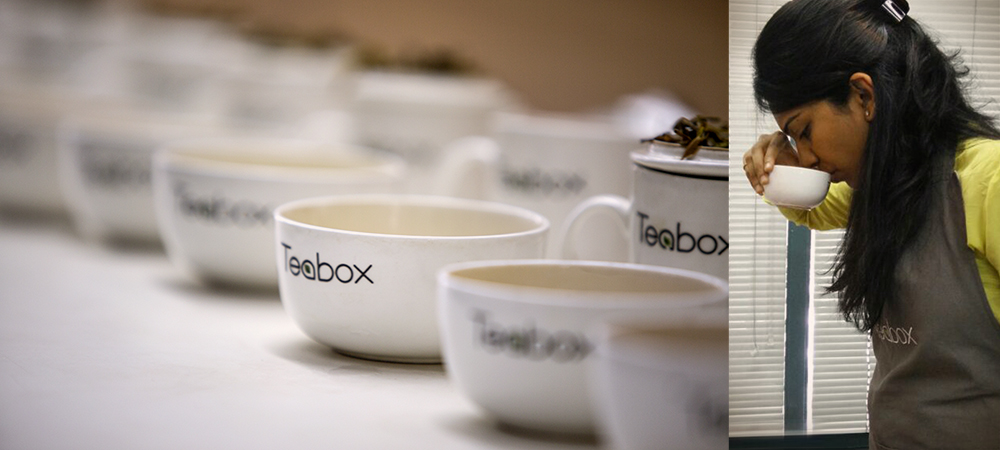I write this post sipping on Kesar Delight, one of Shruti’s master creations, a captivating brew of Darjeeling white tea generously blended with saffron strands, with a sprinkling of lemon grass and chamomile flowers. It’s an indulgent tea. Truth be told, every sip feels like a divine intervention and rich flavors keep popping at you with every sip.
“I am quite proud of Kesar Delight its the first blend I created at Teabox,” says Shruti. Sitting in the Teabox office in Siliguri, she rarely emerges from her tea bubble but once in a while she has the time for a longish chat and it veers toward tea. Shes my go-to-person for all things tea, whether I am buying some, tasting some or writing about some.
How she managed to venture into this unusual vocation is a tale she tells as quite matter-of-fact. “My dad runs a mushroom processing unit back home in Hyderabad, and he would travel extensively all over the world for his business. This was my initiation into the world of food science. I graduated in Food Technology and then went on to do a Masters at Univ. of Arkansas at Fayetteville. From there to Seattle as Product Developer with Starbucks where I became a tea blender.”
Tasting days: From amateur to pro
Back while she lived in the States, Shrutis role as a tea blender meant replicating classic blends, or creating new ones and then perfecting them to be nothing short of empirical. I imagine cold rooms, pristine white coats, hairnets and clinical efficiency. “Yes, there were lab coats and gloves and clinical efficiency but it was also warm and a lot of fun. I loved it,” she says. Siliguri is radically different. It’s a smallish town where malls are sprouting in a hurry. But life is still laidback and people here are partial to the Darjeeling tea.
When she has tea tastings, Shruti is out of the house by half past six without even a morning cuppa to wake her up (It affects the palate .) She dresses casually, doesn’t splurge on fragrances (“They affect the flavors when I am tasting or blending.”) and enjoys Joyda’s chai as much as Jungpana’s First Flush. But I am curious, is she happy to be back in India, and live in a nondescript town like Siliguri? “I am so close to Darjeeling!” she says, surprised that I should even ask it.
Last summer, while still living in Seattle, Shruti came across a New York Times story on Teabox and it had her dashing out an email, thrilled that she just might be able to work closer to the tea gardens. Twenty days later she was on her flight back to India. I taste the finest teas in the world! Where I worked with 8-10 teas, today I work with a library of teas! And everyday I try teas different kinds of teas! Okay, I am convinced although I worry about her caffeine levels when she tells me that she samples between 40-45 teas in a week.
The art and science of blending
Mums across the country have always thrown in spices into the chai. Everyone has her own secret recipe for the kadak masala chai. But professionally, tea blending is still pretty new in India. What makes a good blender, I ask. “A good blender is usually a very fussy person,” she states. She takes out her porcelain cups. “They must love the tea in its pure form even before it enters a blend. Her teas, spices, herbs and other treasures come out. You must be a good taster and a good mixologist,” she continues as she steeps, mixes, infuses, sniffs, and tastes. She does this over and over until she is happy with the blend she holds. It’s a performance, it’s ceremonial, it begins with a blank canvas, it needs inspiration, it demands perfection, it’s a familiar drill… “tea blending is an art,” I exclaim. “Pure science,” she insists. And on this we differ.
The only challenge perhaps is to battle universal subjectivity. Her panel of guinea pigs includes everyone she works with. “Here,” she says, thrusting a cup into the packers hands. “Is it good?” Some nod vaguely, unwilling and unable to offend, some are not sure what the right answer is, others are enthusiastic in their encouragement. A rare few like Gomden sir (old tea hand) will offer critical feedback. “Teabox’s customers are well educated about tea itself and actively seek high quality teas. So I work on creating straight blends (tea with tea) and Indian chai blends (tea with natural Indian ingredients).”
Perhaps more than anything, it’s in finding the hero of the blend, a tea that is stand-out on its own. And what better place to do that than the foothills of the finest tea gardens, with a view of the mountain on the horizon, sipping hot chai and waiting for the freshest pick of leaves to arrive.


1 Comment
I want best dust howcan I prepar plz help me